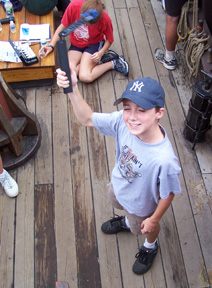 |
|
|
|
|
This page focuses on weather science. Meteorological phenomena can present an extra challenge for our student researchers, simply because weather patterns are generally less predictable than the river's tidal cycles. Even so, the skies above always have much to say to the crew of a sailing vessel. |
Quick Links: Current Speed |
Solar EnergySolar energy forms the heart of every river ecology; sunlight fosters algae and plant growth, which in turn forms the bottom rung of the ecology's food chain. For his aspect of the Port Watch presentation, Adam decided to test just exactly how much energy we've been getting from the sun. He first mounted a photovoltaic cell atop the helm hutch, then took regular readings of the cell's electric output over the course of a day. His research period was also marked by constantly shifting weather as a series of storm fronts passed over us. This gave us an opportunity to compare the solar cell's output under clear vs. overcast skies. Of course, Captain Hudson and his crew in 1609 had no photovoltaic cells on their ship, but they did make use of solar energy in their own way. For example, one of their staple foods was dried cod, and establishing trade for beaver pelts saved the voyage (economically speaking). Both the fish and the pelts were prepared in the same way: by stretching them out on wooden frames to be dried by the sun. |
|
HumidityFor his part of the presentation, Kyle studied relative humidity levels: the amount of water vapor in the air. (It is, in a sense, the mirror opposite of dissolved oxygen in the water.) Unlike some weather phenomena, humidity has little effect on the Half Moon, but the same cannot be said of its crew. (The heat and haze of the first few days of the voyage resulted in a lot of hot, tired sailors.) To study humidity levels over the course of a day, Kyle relied on both a barometer (above left) and a sling psychrometer. Move your mouse over the image of Kyle to the right to see a sling psychrometer in use. The psychrometer contains both wet and dry bulb thermometers. By slinging the psychrometer around, its user induces evaporation from the wet bulb, cooling it. The resulting temperature difference between the wet and dry bulbs can be used to measure humidity -- the drier the air, the cooler the wet bulb becomes. |
|
Celestial Tracking
In the 17th century (and indeed, long before and after those days), celestial navigation was a crucial aspect of nautical life. For her report, Meaghan tracked the positions of both the sun and the moon through a full 24-hour period. To the above right, Meaghan uses a quadrant to measure the angle of the sun above the horizon. Hudson himself would have used this instrument to determine his latitude (his position on the north-south axis of the globe). The quadrant is so named because it forms one quarter of a circle (a 90-degree angle). 0 degrees represents the equator, while 90 degrees represents the north pole. Gravity pulls the dangling plumb bob straight down toward the center of the Earth. A navigator in the northern hemisphere can look up along the quadrant's flat edge to observe Polaris, the north star; the resulting angle indicated by the plumb bob would then indicate the user's northern latitude (see the daily logs for our latitudes throughout the voyage). Of course, by hiding a navigator's celestial reference points, overcast skies can prove a serious annoyance. This holds true whether you're just trying to observe the moon for a project or a sailor lost at sea in the Northern Atlantic. |
|
Our students use hand-held anemometers to accurately measure the wind's speed. As the wind blows through and spins an anemometer's fan, the electronic instrument records the wind's highest and average speeds.
|
|
Ericka and Madena joined forces in a collaborative study of wind speed. Each half hour during their research period, one would take a reading from the weather deck, while the other would go aloft to take a reading from the mast tops. Their findings indicated that the wind is consistently stronger at higher elevations. This would have come as no surprise to the shipwrights who constructed the original Half Moon in 1608; after all, top masts are desined specifically to grab those higher, more powerful gusts. |
|
Comparative TemperaturesLastly, Ciara's chosen topic staddled the arenas of water and weather science. Throughout her research period, she would take temperature readings of both the air and water just at the river's surface. Her goal was then to discover if or how the air temperature affected the water temperature, and vice versa. Since all of Ciara's readings were taken from the surface, she had no need for the Van Dorn sampler; one of our canvas buckets proved perfectly suitable instead. To the left, Ciara gathers a water sample. To the right, Ciara wields the tools of her trade: a thermometer, a bucket, and a notebook full of data. |
|


